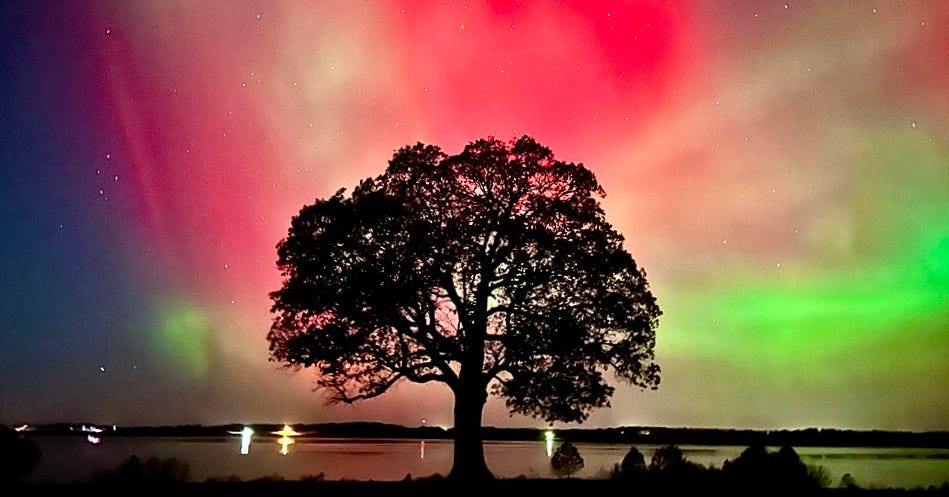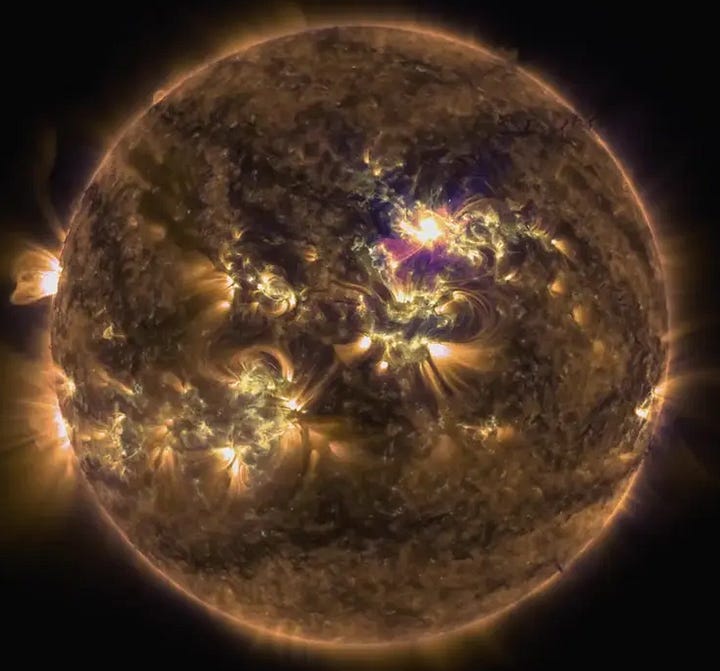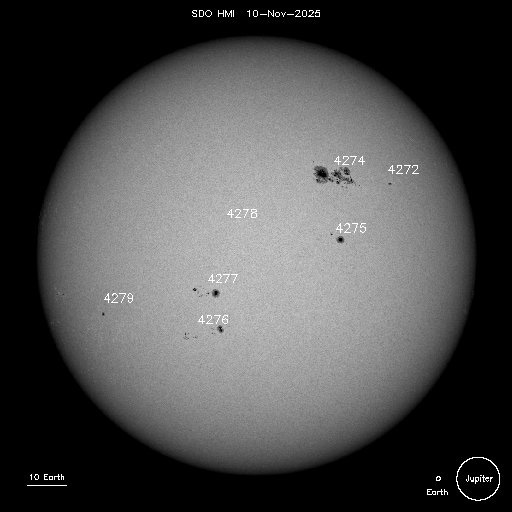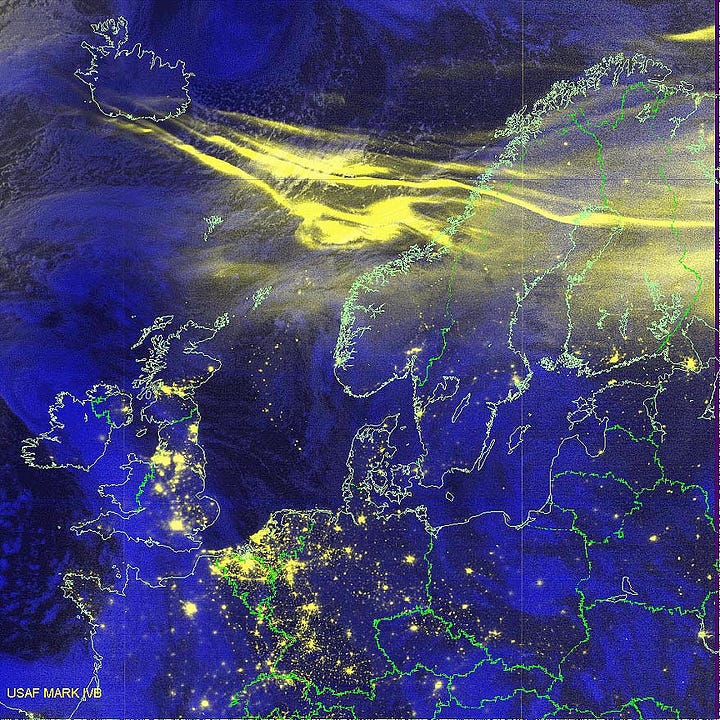The Biggest Solar Flare of 2025
A flare hits Earth. But when will a really big one come?

In some ways it is surprising this doesn’t happen more often. Every now and then, a piece of the boiling, bubbling, nuclear furnace we call the Sun escapes out into space. Most of the time this is harmless enough: the solar system is a big place and Earth makes up very little of it. But sometimes it isn’t. Sometimes the Earth lies in the path of whatever the Sun has decided to hurl at us.
This kind of thing usually starts with the appearance of a sunspot. These dark blemishes sporadically mar the surface of our star, and tend to cluster in groups known as active regions. They look dark because they are cold, or at least cold compared to the rest of the Sun, and so they shine a little less brightly than their surroundings.
Why they appear is not yet fully known. But we do know they are linked to the Sun’s magnetic field, and that this field can sometimes tie itself up in complicated knots. Where these fields emerge from or enter into the Sun they exert a pressure pushing down and so prevent heat from welling up as fast as it normally would. This results in a cooling spot on the Sun, and since these magnetic knots form complex structures which can enter and emerge from the surface in many places, these spots often appear in clusters.
All of this, of course, involves a great deal of energy. Most of this is stored in the magnetic field, and it must eventually be released. Often this happens calmly: the knots gently relax, the flow of heat increases, and the sunspots fade away. But it can also happen violently as magnetic field lines snap and reconnect.
Sudden releases of energy like this create flares. First, the energy accelerates subatomic particles and sends them crashing through the solar atmosphere. That creates a flash of radio waves, X-rays and high-energy gamma rays. These burst away from the Sun at the speed of light, and wash over the Earth within minutes of the eruption.
Alongside these intense flashes of energy, flares can sometimes release clouds of solar material known as coronal mass ejections. Again, we don’t know exactly why this happens or why these are so often linked to flares, but it is this material that is sometimes aimed at Earth. And though these travel fast, they are slow compared to the flare itself. While a flare can reach the Earth in minutes, a coronal mass ejection takes days.


Over the past week, an active region on the Sun labelled AR 4274 has flared up at least four times. Each of these flares was big enough to reach the top “X-class” on the scale used by astronomers. Wednesday’s was the biggest of the year so far, and one of the strongest to erupt this decade.
The first three flares sent coronal mass ejections heading towards Earth, and so treated people across the world to glowing displays of the aurora lighting up the skies. As with other strong magnetic storms, these aurora were seen much further south than normal, and most notably over the Americas and Europe, where they reached as far south as Mexico and Italy.
Fortunately, such things are not directly harmful to us. The Earth is protected by a magnetic shield, and the lights we see in the sky come from particles moving through this invisible barrier. But they can and do impact our technology.
Satellites are vulnerable to the radiation and swings in magnetic fields. The European Space Agency warned of disruption to satellite navigation services. Radio communications were badly affected across Europe and Africa. A planned launch to Mars was postponed: NASA feared the spacecraft might be damaged by the passing storm.


The inevitable comparison, of course, is with the events of September 1859, when a truly colossal flare and coronal mass ejection swept over the Earth. That storm was probably ten times the strength of the one that hit us this week. But it is not the only major solar event of the past two centuries.
Notably, one in 2003 was powerful enough to overwhelm monitoring satellites and damage electrical grids on the ground. Another, probably comparable in size to that of 1859, was seen in 2012. It fortunately missed the Earth – had it struck, the damage might have been catastrophic.
There is no reason to think of the flare of 1859 as an upper size limit. They can probably get bigger, maybe much bigger. How much so is uncertain. The mechanisms behind flares and solar storms are still not well understood, and so this is mostly a question of looking at the historical record. But people haven’t always kept good observations of the aurora, and even if they knew what to look for, cloudy nights can mean even the best observers miss them.
Trees, however, have kept decent records. A particular isotope of carbon is created in the atmosphere during flares, and this is taken up by trees and laid down in their rings. Careful study of old trees, it turns out, can reveal the history of our star.
This work hints at big flares in the past. One seems to have hit around 770 AD, another in 993. Yet the records are patchy, and tree rings aren’t always easy to decipher. Astronomers struggle to say how big these flares were, or even if they were caused by the Sun or were actually some other rare cosmic event.
An alternative is to look at other nearby Sunlike stars. Instead of studying ten thousand years of history, we can monitor ten thousand stars over a single year. These studies have revealed something frightening: flares can indeed get big, far bigger than anything we’ve ever observed. Some stars emit superflares, each a hundred or a thousand times the size of the 1859 event.
Fortunately, they seem to be rare. Sunlike stars emit a superflare once every few hundred years. It could be one of these that struck in 770 and 993. Back then, it would only have sparked dramatic auroral displays in the skies. Today it would wreak havoc on our satellites and connected planet. Still, at least we’d have some pretty lights to admire before the power went out.
Read Next
How Many Alien Civilizations Exist In Our Galaxy?
The Drake Equation goes something like this. First, you work out how often new stars are born. Then you estimate how many of them have habitable planets, ask how many evolve life, guess a few more parameters, and eventually arrive at the number of advanced civilizations that must exist in our galaxy.
The Hasselblad Cameras of Project Mercury
Unless otherwise specified, all images in this article are thanks to NASA and especially to the March to the Moon archive of Mercury, Gemini, and Apollo photography.The Quantum Cat is a reader-suppor…



